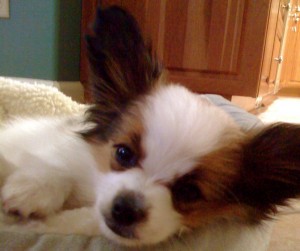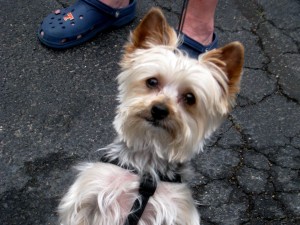 Does your dog or puppy hide from, bark at, chase, bite, your vacuum cleaner? It seems there are a group of dogs who protest whenever we try to clean up!
Does your dog or puppy hide from, bark at, chase, bite, your vacuum cleaner? It seems there are a group of dogs who protest whenever we try to clean up!
If you have a puppy under 12 weeks of age, now is the time to gently expose him or her to everyday events and noises. During the critical period of socialization, these exposures teach our dog lifelong coping skills.
If you are reading this, I imagine your dog is beyond 12 weeks of age. That’s okay. You can still teach your dog to relax when you vacuum.
First off, forget about stopping “barking and attacking the vacuum” behaviors. You will spiral into an abiss of failures if you try to punish these unwanted behaviors. And, even if you succeed, you have not taught your dog any useful skills that may come in handy in other situations. Spend your energy and time teaching your dog an acceptable behavior, which will be incompatible with the unwanted behavior.
And, kindly prevent your dog from practicing “attack the vacuum” behaviors! Have a family member take your dog out for a walk when you vacuum or place the dog in another area with a chew toy. Practice makes perfect! Yikes!
Before you can teach your dog anything, you should identify the components that make up the target behavior. Exactly what does “relax when I vacuum” behavior look like? I picture the dog lying on his or her bed and calmly resting while I vacuum. That’s why you should teach and practice Go-To-Place before you work on “relax for vacuum” behavior.
Anytime you catch yourself saying “NO” or trying to stop any behavior, ask yourself these two questions:
At this instant in time, exactly what do I want my dog to do?
Where do I want my dog to perform this behavior?
The answers are your next training goal!
Teach your dog exactly what to do when you vacuum, and where to do it. I like to use Go-To-Place for the replacement behavior.
You cannot teach your dog to Go-To-Place when you are vacuuming your floor. Set aside time for training sessions to teach your dog Go-To-Place.
Here are the steps for teaching a dog anything you want.
- Condition a reward marker, a signal to tell your dog the instant he or she has succeeded.
- Establish a Rewards System, so your dog will be motivated to cooperate.
- Get the dog to perform the behavior (or some portion of the behavior) during practice sessions.
- Mark the instant your dog succeeds.
- Reward your dog, reinforce the behavior.
- Refine the behavior through repeated practice sessions in many different areas.
- Add distractions so your dog will always perform the behavior.
- Practice the behavior in real life.
Once you have a conditioned reward marker and a Reward System in place, and you have taught your dog to Go-To-Place, you are ready to teach your dog or puppy to relax when you vacuum your floors. The general idea is to expose your dog to the sounds and motions of the vacuum, in such small doses that your dog will remain in his or her place. Each cycle the vacuum is closer to the dog than the previous cycle. Reward your dog for Go-To-Place and NOT BARKING when the vacuum is moving, then when the vacuum is far away and powered on, when the vacuum gets closer, et cetera. Here’s how
Place the vacuum cleaner in the room with your dog nearby. Plug the vacuum cleaner into the outlet, but do not turn it on. Tell your dog to Go-To-Place.
Reach for the handle. If your dog does not bark, or get off his or her place, deliver your reward marker. Toss your dog a food treat. Repeat 3 times. Each time you touch, mark, and toss treat is called a cycle or trial.
Reach for the handle and push the vacuum a few inches. If your dog does not bark, or get off his or her place, when you push the vacuum a few inches, deliver your reward marker and toss your dog a food treat. Repeat 3 times for a total of 4 cycles. If your dog barks or attacks the vacuum cleaner when you push it, go back to the previous step (touch the handle, mark and treat) and perform several more cycles.
Reach for the handle and push the vacuum (the vacuum is still off, not turned on) a few feet. If you dog does not bark, or get off his or her place, when you push the vacuum a few feet, deliver your reward marker and toss your dog a food treat. Repeat 3 times for a total of 4 cycles. If your dog barks or attacks the vacuum cleaner when you push it a few feet, go back to the previous step (push the vacuum a few inches) and perform several more cycles.
Once you can push the silent vacuum around the room while your dog stays quietly in his or her place, you are ready for these next steps. You’ll need a helper.
Have your helper take the vacuum in another area of the house, as far away from your dog’s place as possible. Close the door to the room (if applicable). You stay with your dog in the same room as the dog’s bed (or place). Have your helper turn on the vacuum for a few seconds and then turn it off. As soon as you hear the vacuum, tell your dog to Go-To-Place. Mark the instant he or she gets on the dog bed. Toss a food treat. Praise your dog. Coax your dog off the bed.
Again, instruct your helper to turn on the vacuum for a few seconds and then turn it off. This time it will be on for a few more seconds than before. Tell your dog to Go-To-Place, mark and treat. Repeat several times, each cycle the helper will keep the vacuum cleaner running for more seconds. Repeat until the helper can leave the vacuum running and your dog will calmly remain in his or her place.
Repeat the sequence from the beginning (vacuum on for a few seconds, then off), but open the door to the room with the vacuum or move it closer to you and the dog. Continue to practice in cycles, each cycle the vacuum is closer and closer to you and the dog. After several carefully planned practice sessions, your dog will know exactly what to do when the vacuum is running and where to do it.
When you start vacuuming in the same room, don’t be greedy. 🙂 Run and push the vacuum a few inches and then turn it off and reward your dog for staying in place. Gradually increase the duration of the vacuuming before you reward your dog.
Happy Training!
Alan J Turner – Dog Trainer in Memphis, Collierville, Germantown, Cordova, Bartlett, Arlington, TN
How’s Bentley –
Private and Group Dog Training
In the picture, Java the Papillon is resting in his “Place” or bed.


